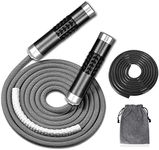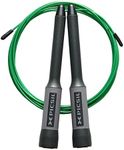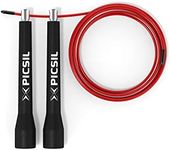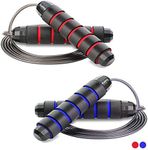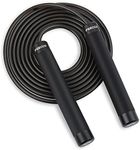Buying Guide for the Best Jump Ropes
Choosing the right jump rope can make a big difference in your workout experience, whether you're a beginner or an experienced athlete. The best jump rope for you will depend on your fitness goals, skill level, and personal preferences. It's important to consider the main features of a jump rope to ensure it matches your needs, feels comfortable in your hands, and helps you achieve your exercise objectives.Rope LengthRope length is the measurement from one end of the rope to the other, and it's crucial for comfortable and effective jumping. If the rope is too short, it will catch on your feet; if it's too long, it will be hard to control. Most ropes are adjustable, but some come in fixed lengths. For beginners, a rope that reaches your armpits when you stand on the middle is a good starting point. Shorter ropes are better for speed and advanced tricks, while longer ropes are more forgiving for beginners. To pick the right length, consider your height and whether you want to focus on speed, tricks, or general fitness.
Rope MaterialThe material of the rope affects its weight, speed, and durability. Common materials include PVC, leather, fabric, and steel cables coated with plastic. PVC ropes are lightweight and good for beginners or general fitness. Leather ropes are heavier and offer a classic feel, often used for boxing training. Steel cable ropes are very fast and best for advanced users focusing on speed or double-unders. Fabric ropes are softer and slower, suitable for children or casual use. Choose the material based on your skill level and workout style—lighter for beginners, heavier or faster for advanced routines.
Handle Type and GripHandles come in various shapes, sizes, and materials, affecting comfort and control. Some handles are cushioned or have a textured grip to prevent slipping, while others are smooth. Longer handles can help with tricks, while shorter handles are better for speed. If you have sweaty hands or plan to jump for long periods, look for handles with good grip. Try different handle types to see what feels most comfortable and secure for your hands and jumping style.
WeightThe weight of the rope and handles influences how the rope moves and how much effort is required. Lightweight ropes are easier to spin quickly and are ideal for speed work or beginners. Heavier ropes provide more resistance, making your workout more challenging and helping to build strength. If you're new to jump roping, start with a lighter rope to learn the basics. If you want to increase intensity or build upper body strength, consider a weighted rope.
Rotation MechanismThe rotation mechanism refers to how the rope attaches to the handles and how smoothly it turns. Some ropes use simple knots, while others have ball bearings for smoother, faster rotation. Ball bearings reduce friction and make it easier to spin the rope quickly, which is helpful for speed jumping and advanced tricks. If you want a smooth, tangle-free experience, especially for fast or frequent jumping, look for a rope with a quality rotation mechanism.
